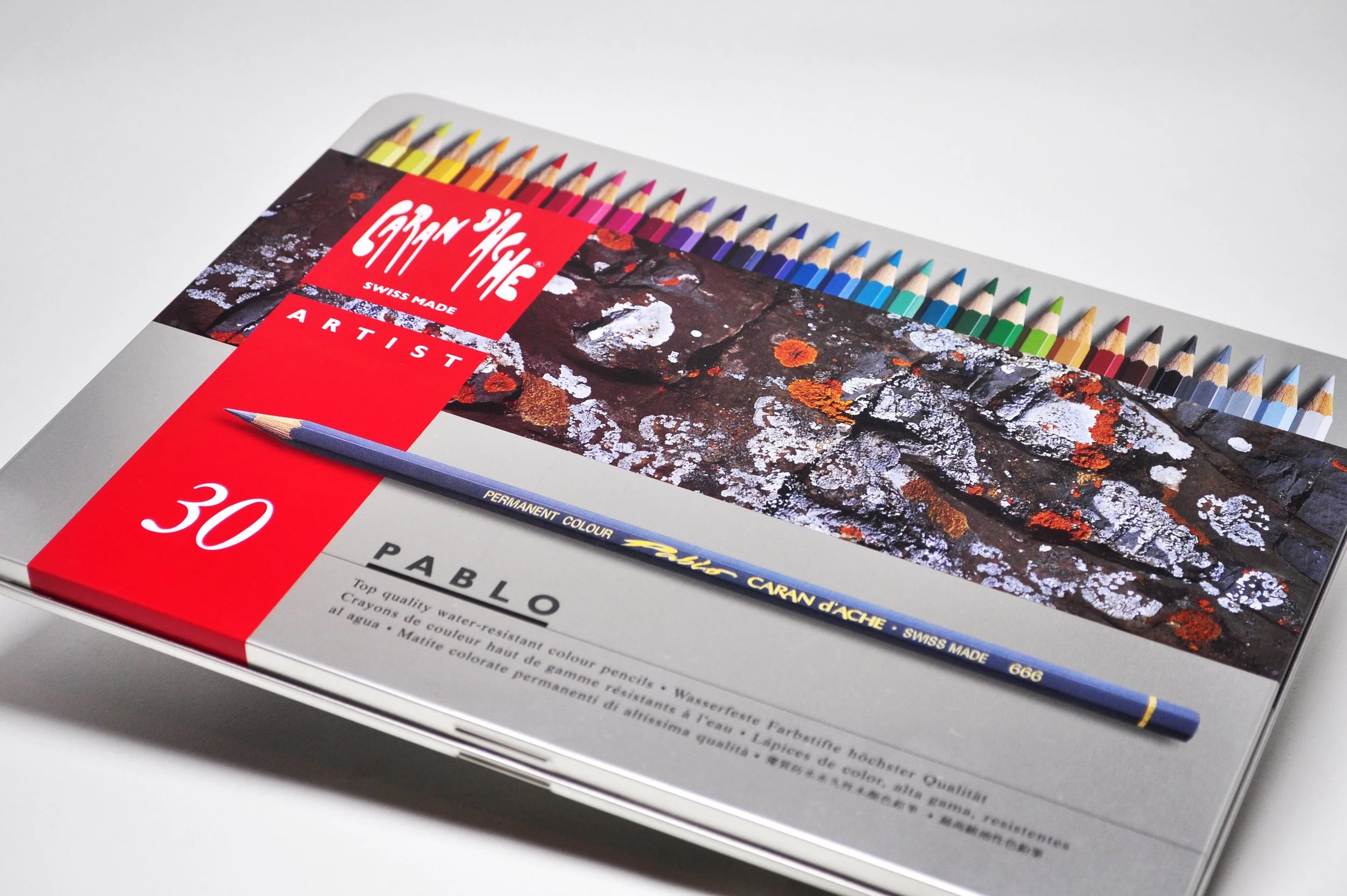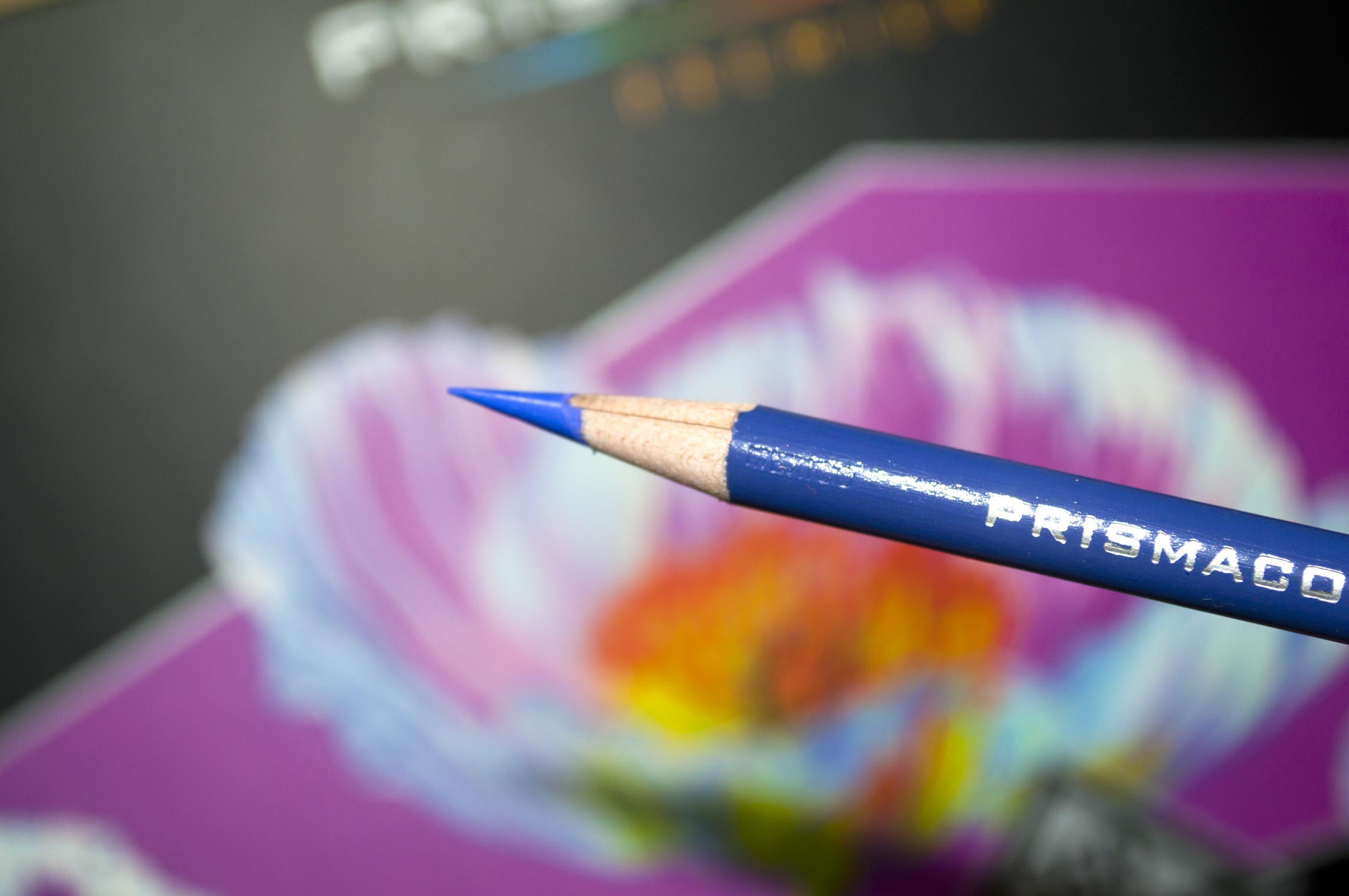Prismacolor Col-Erase
Prismacolor Col-Erase
Whether you love or hate Prismacolor as a company or their products, there is absolutely no denying that they are a massive hitter in the colored pencil community, especially in America. I've heard many artists talk fondly of Prismacolor Premier colored pencils, remembering them from their youth, perhaps even recalling their parents using Prismacolor. However, more recently Prismacolor has been getting bad press in the colored pencil community, primarily for their quality control issues and less so for the pencils performance. So when I was asked to review the Prismacolor Col-Erase, I was both excited and dubious, simply based on previous experiences with the Premier brand of pencils.
Col-Erase Specifics
The Prismacolor Col-Erase are a hexagonal shaped pencil, which many colored pencil artists prefer due to their stability whilst sat on a drawing board, making the pencil a less likely candidate to roll off, hit the floor and shatter the precious core. The Hexagonal shaft is a slim 7mm Cedar Wood casing, encased in which is the fragile 3.6mm core.
The most noticeable difference between these colored pencils and most on the market, is the fact every pencil in the set is accompanied with an eraser on the end of the pencil, very similar to your run of the mill graphite pencil, used in millions of schools across the world. So, with this being the main selling point, you would expect the pigment of the pencil to be easily erased, after all, the clue is also given in the name of the pencil; "Col-Erase", however we shall see further into the review as to whether or not they actually live up to their claim.
All colored pencils have information printed along the body of the pencil, information that in most cases can be quite important to the artist. From core to end is printed the following. Very faintly and difficult to make out, you can see the word Mexico, indicating the place of origin for the pencil. Next is the name of the company, "Prismacolor" followed by the brand of the pencil which in this case is "Col-Erase". Further along is a numerical code which relates to the pigment of the pencil should you wish to purchase that particular pencil. Finally, closest to the end or in the case of the Col-Erase, the eraser, is the printed name of the pigment color.
Col-Erase Sets
This is perhaps the most frustrating and puzzling aspect of the Prismacolor Col-Erase pencils. They are only available in two sets, a set of 12 and a set of 24, making 24 the largest color palette for this particular range, making me question, where exactly would a set of Col-Erase fit into a colored pencil artists arsenal, or even a student artist for that matter. Strangely enough, given how small the color palette of the Col-Erase is, the Col-Erase is still also sold open stock, meaning you can purchase pencils individually.
The pricing of the Prismacolor Col-Erase is a bit on the high side, which if they live up to their claim of erasability, makes them a bit unique and perhaps warranted, however, we shall see if this is the case
The color palette is very basic, which is what you would expect from a set containing only 24 colors, so the next big question would be how they perform? Perhaps their performance can help one over look the small palette, allowing for a reasonable blending experience, bearing in mind however that we are dealing with colored pencils here and not watercolor, there is only so much you can do with regards to blending.
Col-Erase Performance
The performance of the Col-Erase was a big deal for me, purely based on the terrible experience I had with the Prismacolor Premier pencils. don't get me wrong, I have mentioned this on many occasions; I absolutely love the Prismacolor Premier pencils, their creamy core is to die for, however, the quality control issues are just too prominent and frustrating.
The first thing I noticed when opening the Col-Erase packet was that none of the pencils had been sharpened, which I actually feel is a good thing as I personally feel this is a safer and more protective mode for the pencils to be in during transit, protecting the core from knocks and bangs.
When sharpening the pencils, I could immediately tell that the wood casing was of a lower grade than most pencils in the student or artists category. There is a chance, that I may have just picked up a faulty batch, never the less, there was resistance and splitting of the wood in every pencil. I tried a few of my sharpeners to make sure it was not just a blunt blade, but to no avail. When I finally had the pencils sharpened, the snagging of the wood barrel and splitting of the wood was evident in the cores with little nicks of the cores chipped off. You can see from the images I took, that the sharpening of the pencils was not a smooth process. I will say this however, the Col-Erase faired much better than the Premier pencils, although the wood casing seemed to be the main problem in the Col-Erase, none of the cores shattered completely or fell out of the barrel like they did with my Prismacolor Premiers.
When laying down the color it was really difficult to tell if they were wax or oil based, the Col-Erase were neither soft and creamy or hard, but at the same time you could tell that they were not your average dollar store colored pencils. Incidentally the Col-Erase are a wax based pencil, but not as soft and creamy as the Premier.
The vibrancy of the colors was certainly not to the same high standard that we all know and love the Premier pencils to be, never the less, when medium to heavy pressure was applied, a decent coverage was produced. As you can see from the images below, when I am testing the core of all colored pencils, I apply one light layer, followed by approximately five light layers building up to one over all beautiful coverage and then finally I apply one heavy application. As you can see from the results of my test with the Prismacolor Col-Erase, the light layer is very difficult to see and the five light layers do not match the vibrancy of similar pencils in the Col-Erase range.
For me personally, I would definitely categorise the Prismacolor Col-Erase as Student grade pencils and even then, this would be a stretch. I really couldn't see a set of these fitting into a high end colored pencil artists tool box, which in all honesty is more than likely not what they had been developed for by Prismacolor.
Another very important factor for the Col-Erase being redundant from a high end colored pencil artists tool box is the lightfast rating. Unfortunately there is no lightfast rating for the Prismacolor Col-Erase, making them impossible for a colored pencil artist to use. In simple terms, lightfast pertains to the pigments ability to remain vibrant throughout many years of constant sun light touching the pigment. Without a high lightfast ability, a beautiful work of art, after hanging on a wall for many years, will fade and lose its beautiful color.
The Erasing Of The Col-Erase
Going back to my question early on in the review, focusing in on the main feature or selling point of the Col-Erase; the ability to erase the pigment from the paper and whether or not this is a special formula built into this particular pencil, we shall look at this now.
All colored pencil artists know that, when working with their favourite go to colored pencil, they normally work in light layers, just in case they need to erase the pigment. For the most part, this can happen with all and any colored pencils. If you need to lift or remove pigment from a project, you can use pretty much any eraser and remove the pigment. So, when I seen the Prismacolor Col-Erase, I assumed that in order to be actually sold as a pencil that can erase pigment, there was perhaps some special resin in the pigment or perhaps the eraser on the end of the pencil was a special eraser.
I conducted a test using the red Col-Erase pigment, as red is notoriously difficult to remove. I applied a medium pressured layer and used the Col-Erase eraser to lift some pigment. Next I used the TomBow Mono Eraser and finally I used the Derwent Battery Eraser. As you can see from the results, there really is no difference in the abilities of the various erasers to remove or lift the pigment. In fact, if I had to select the best eraser I would have to select the battery eraser, which I know is a bit unfair.
However, the Col-Erase are being sold as colored pencils that can be erased and on the bases that they have their own eraser attached to each individual pencil, you would be forgiven for thinking that as I have mentioned, the eraser was specially formulated to lift the pigment, or the pigment had a resin specific to the pencil allowing the attached eraser to lift the pigment better, but this was not what I discovered.
Conclusion
I think the Prismacolor Col-Erase would be perfect for school grade children, young children drawing diagrams or art whilst at school and likely to make a lot of mistakes and although as I have mentioned, any eraser will lift or remove colored pencil pigment just as well as the Col-Erase, I think in this example, the matter is convenience.
I would say that given the situation above, the cost of the Col-Erase becomes a bit of an issue. As previous mentioned in the sets section, here in the UK, for a set of 12 Col-Erase it is going to cost close to £10 and for a set of 24 you are going to spend approximately £20. In the case of America you will be looking at $8 for a set of 12 and $16 for a set of 24. When you think of the alternatives for this price bracket, you must consider if the erasing convenience is really what you are looking for.
Prismacolor is a huge name in the colored pencil community, a name that although recently has certainly sparked debate, still commands respect. I personally think the Col-Erase brand falls into the realm of gimmicks. I really don't like writing what may appear as negative reviews for products, however, I must write how I really see the product and how I feel about the product in certain settings. Don't forget to check out my YouTube video of this review also.











